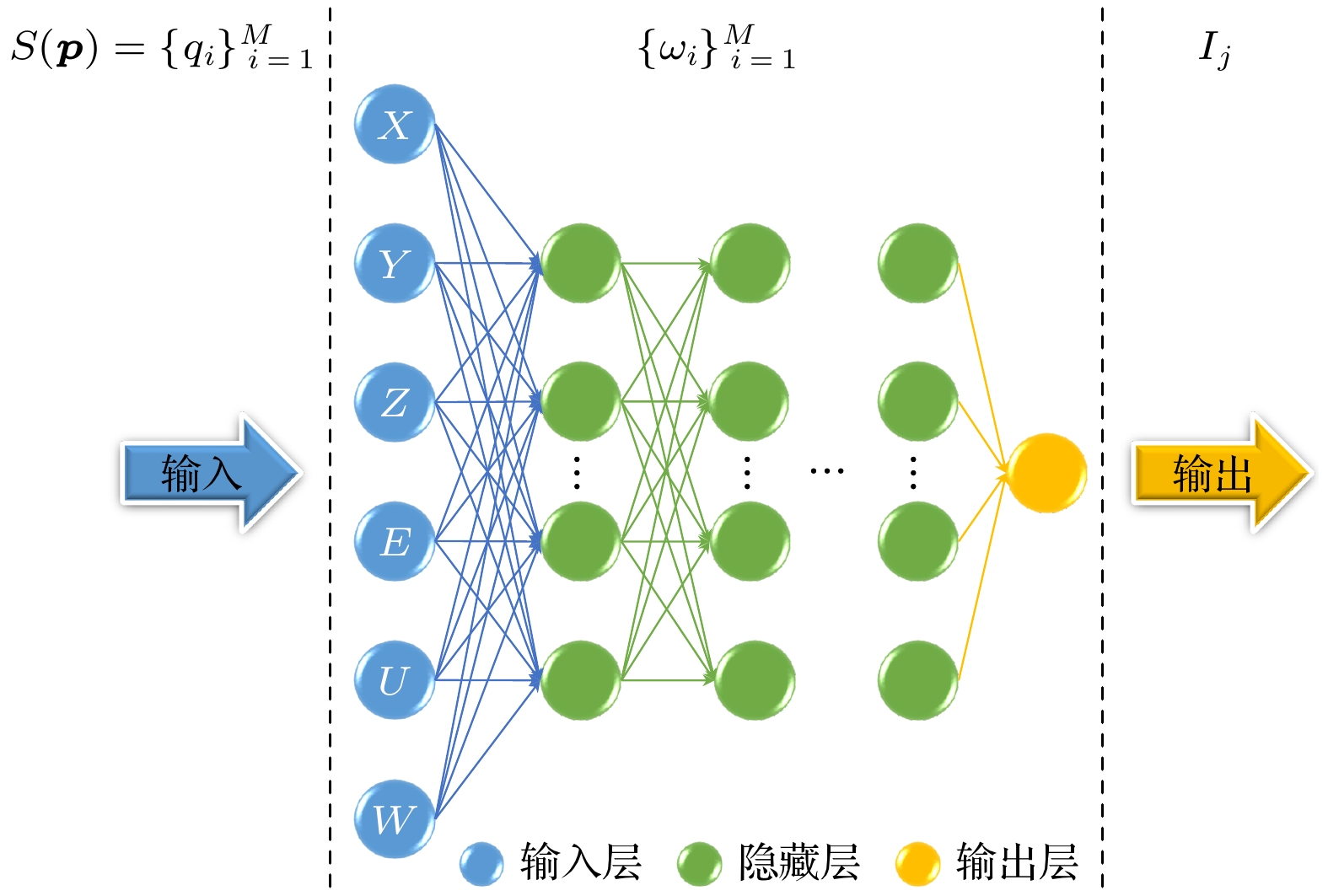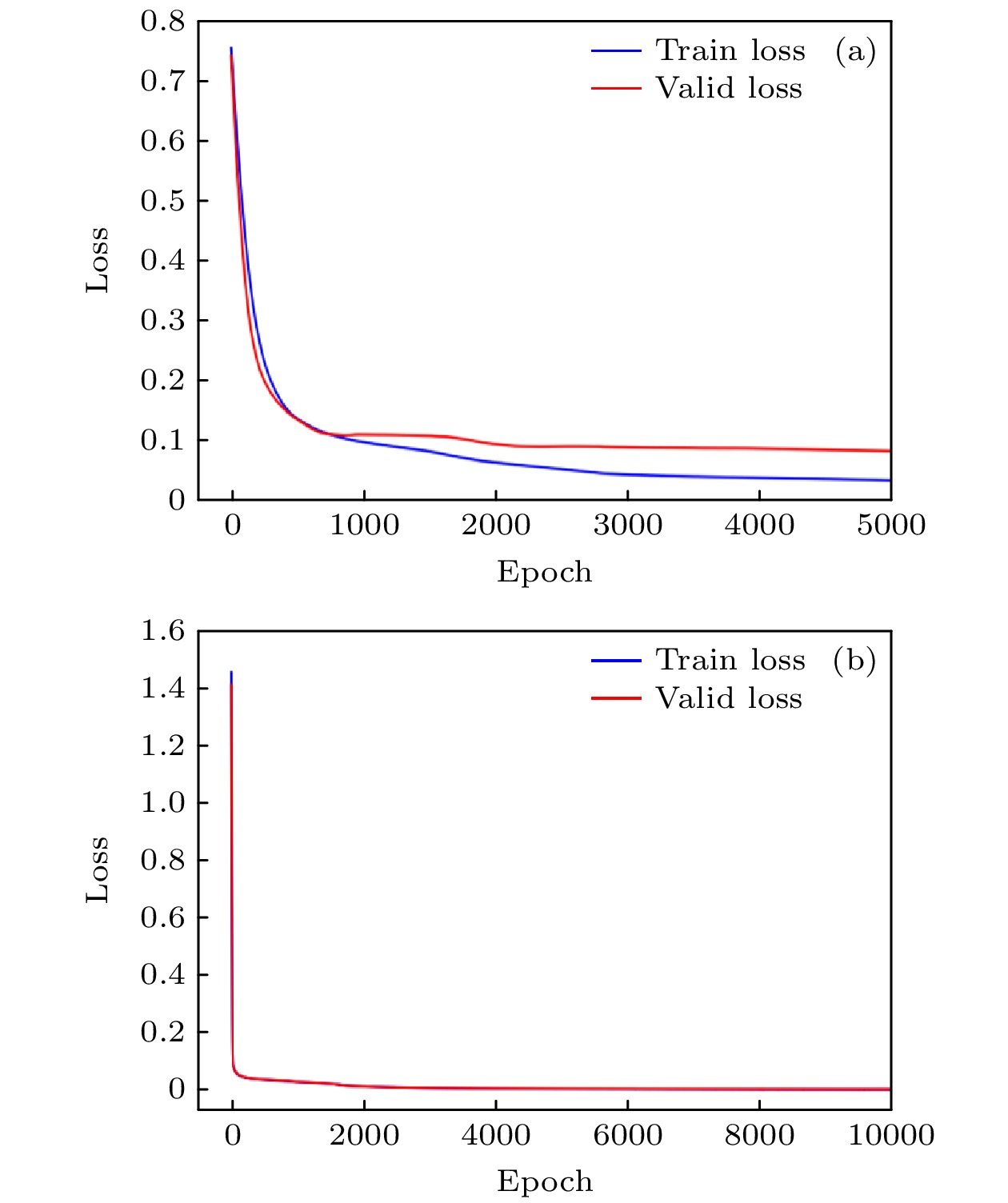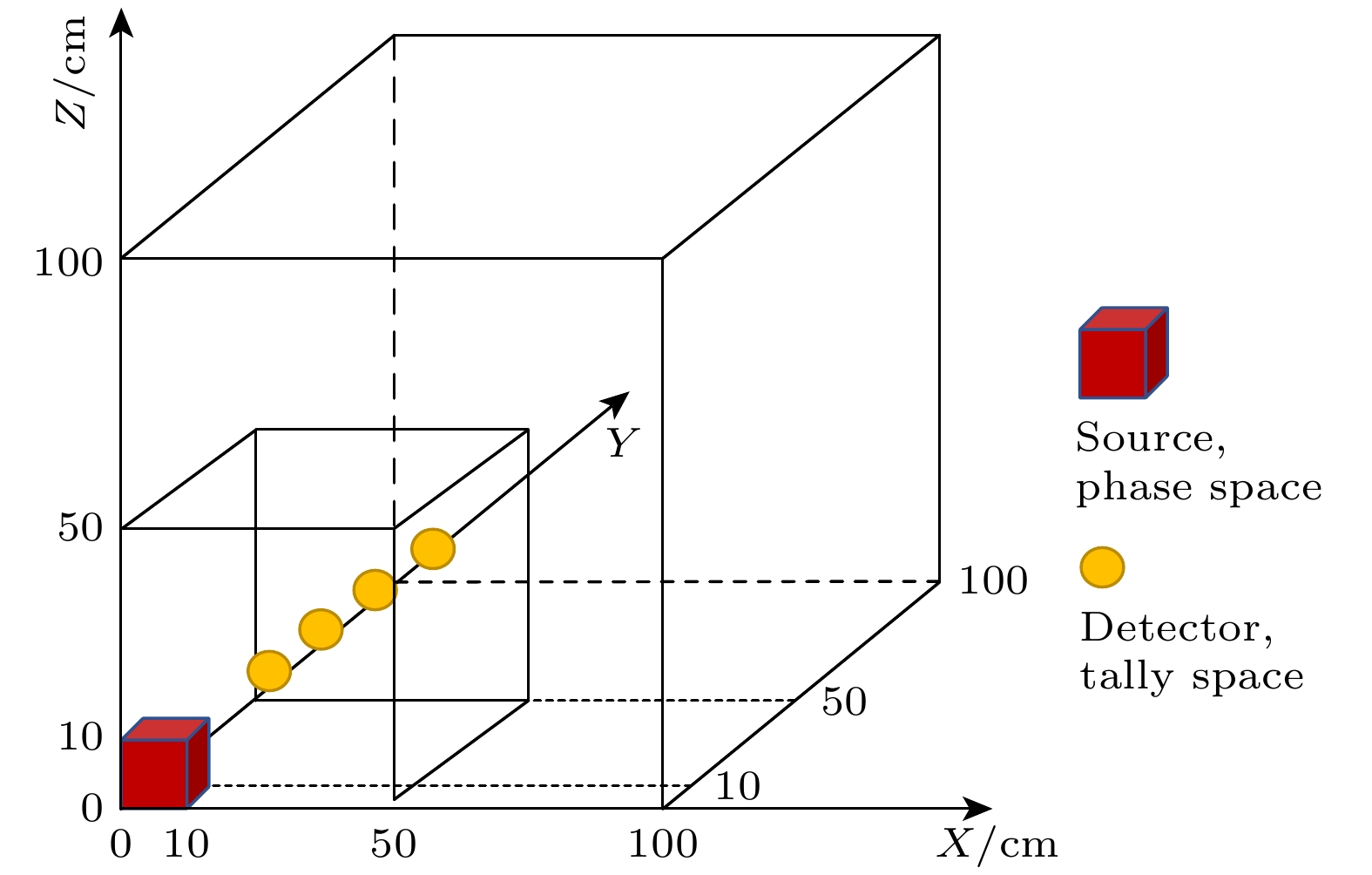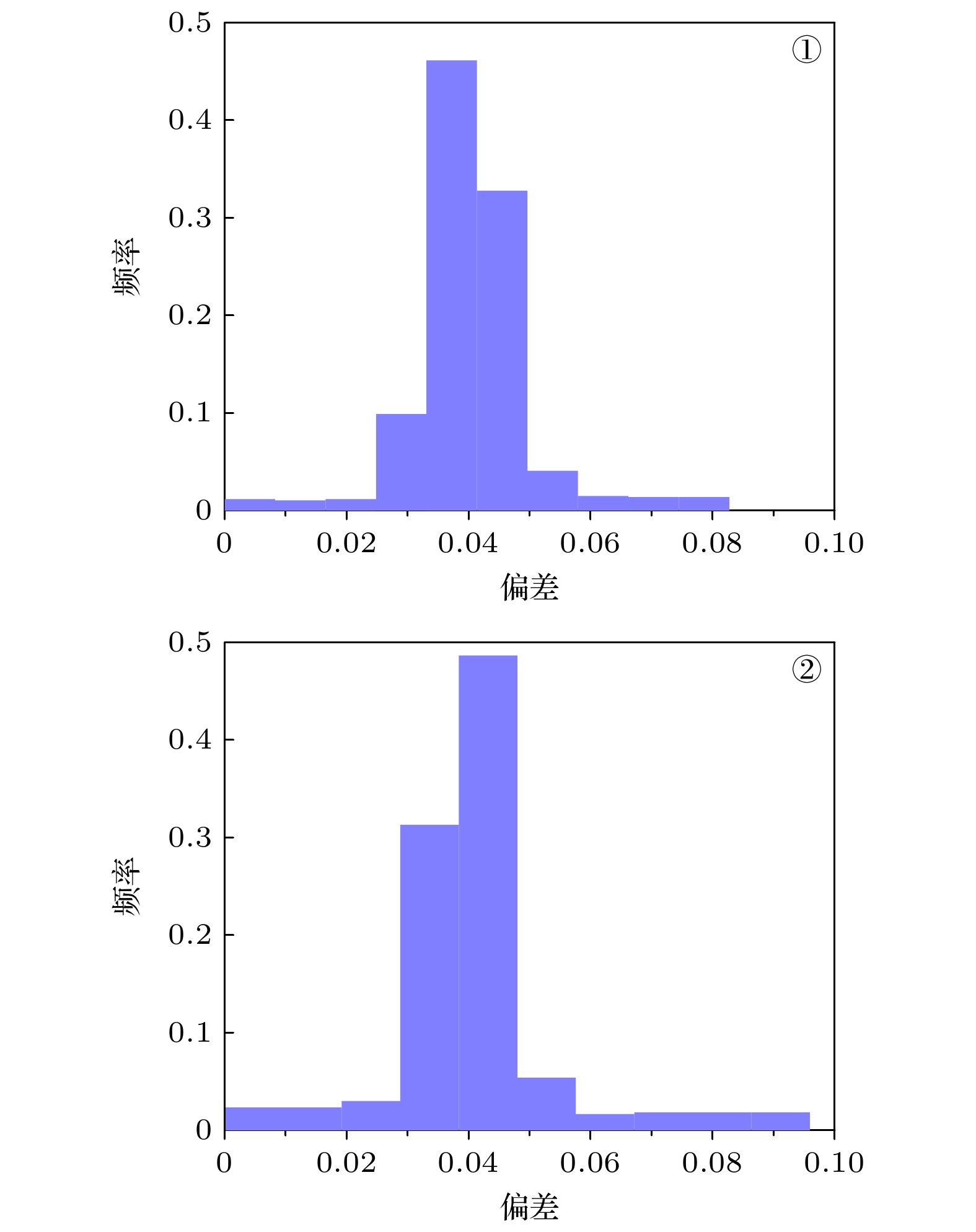-
蒙特卡罗方法是求解粒子输运问题的有力工具之一, 其局限性在于为达到精度要求需模拟大量粒子, 计算耗时长, 这阻碍了该方法的进一步应用, 尤其在需快速响应的情形. 本文结合神经网络和若干蒙特卡罗方法基本原理发展了一种计算方法, 能够实现源分布可变, 几何、材料和目标计数不变的中子输运问题的快速准确求解. 首先, 为高效生成用于神经网络训练的数据, 利用重要性原理实现在同样模拟次数基础上有效扩充训练数据集容量, 在一定程度上克服了使用蒙特卡罗计算获取训练数据耗时长的缺点. 进而, 基于目标计数是源分布与重要性函数乘积积分的事实, 设计了利用神经网络实现快速输运计算的策略. 该网络的输入是中子源项, 输出是目标计数, 在几何、材料和目标计数固定的情况下, 该神经网络可重复使用, 根据新的源项快速准确得到目标计数. 本文所提出方法的原理和框架同样适用于其他种类粒子的同类型输运问题. 基于若干基准模型的验证表明, 训练得到的神经网络能在不到1 s的时间内得到目标计数, 且与蒙特卡罗大样本模拟得到基准结果的平均相对偏差均低于5%.Monte Carlo (MC) method is a powerful tool for solving particle transport problems. However, it is extremely time-consuming to obtain results that meet the specified statistical error requirements, especially for large-scale refined models. This paper focuses on improving the computational efficiency of neutron transport simulations. Specifically, this study presents a novel method of efficiently calculating neutron fixed source problems, which has many applications. This type of particle transport problem aims at obtaining a fixed target tally corresponding to different source distributions for fixed geometry and material. First, an efficient simulation is achieved by treating the source distribution as the input to a neural network, with the estimated target tally as the output. This neural network is trained with data from MC simulations of diverse source distributions, ensuring its reusability. Second, since the data acquisition is time consuming, the importance principle of MC method is utilized to efficiently generate training data. This method has been tested on several benchmark models. The relative errors resulting from neural networks are less than 5% and the times needed to obtain these results are negligible compared with those for original Monte Carlo simulations. In conclusion, in this work we propose a method to train neural networks, with MC simulation results containing importance data and we also use this network to accelerate the computation of neutron fixed source problems.
-
Keywords:
- Monte Carlo method /
- neural network /
- particle transport /
- importance principle
[1] Wu Y C 2017 Fusion Neutronics (Singapore: Springer Singapore) p21
[2] 邓力, 李刚 2019 粒子输运问题的蒙特卡罗模拟方法与应用 (北京: 科学出版社)
Deng L, Li G 2019 Monte Carlo Simulation Methods and Applications for Particle Transport Problems (Beijing: Science Press
[3] Shangguan D H, Yan W H, Wei J X, Gao Z M, Chen Y B, Ji Z C 2023 Nucl. Sci. Tech. 34 58
 Google Scholar
Google Scholar
[4] 上官丹骅, 闫威华, 魏军侠, 高志明, 陈艺冰, 姬志成 2022 71 090501
 Google Scholar
Google Scholar
Shangguan D H, Yan W H, Wei J X, Gao Z M, Chen Y B, Ji Z C 2022 Acta. Phys. Sin. 71 090501
 Google Scholar
Google Scholar
[5] Martin W R 2012 Nucl. Eng. Technol. 44 151
 Google Scholar
Google Scholar
[6] Noh K, Lee D 2013 Proceedings of the KNS Fall Meeting, Gyeongju, Korea, 2013, October 23–25
[7] Hassan M 2020 Int. J. Sci. Res. 9 913
 Google Scholar
Google Scholar
[8] Gul A 2016 Prog. Nucl. Energy 92 164
 Google Scholar
Google Scholar
[9] Huang Z P, Cao L Z, He Q M, Wu H C 2022 J. Nucl. Sci. Technol. 59 1375
 Google Scholar
Google Scholar
[10] García-Pareja S, Lallena A M, Salvat F 2021 Front. Phys. 9 633
 Google Scholar
Google Scholar
[11] Pooneh S, Mahdi S, Claudio T (Victor C Ed.) 2013 Theory and Applications of Monte Carlo Simulations (Rijeka: IntechOpen) pp152–172
[12] Dubi A 1985 Transport Theor. Stat. 14 167
 Google Scholar
Google Scholar
[13] Dubi A 1985 Transport Theor. Stat 14 195
 Google Scholar
Google Scholar
[14] Booth T E, Hendricks J S 1984 Fusion Sci. Technol. 5 90
 Google Scholar
Google Scholar
[15] Davis A, Turner A 2011 Fusion Eng. Des. 86 2698
 Google Scholar
Google Scholar
[16] Wagner J C, Haghighat A 1998 Nucl. Sci. Eng. 128 186
 Google Scholar
Google Scholar
[17] Wagner J C, Peplow D E, Mosher S W 2014 Nucl. Sci. Eng. 176 37
 Google Scholar
Google Scholar
[18] Sun A K, Chen Z P, Li L M, Liu C W, Yu T 2022 Proceedings of the 23rd Pacific Basin Nuclear Conference Beijing, China, November 1–4, 2022 p821
[19] Ramón J, Peña J 1995 Comput. Phys. Commun. 88 76
 Google Scholar
Google Scholar
[20] LeCun Y, Bengio Y, Hinton G 2015 Nature 521 436
 Google Scholar
Google Scholar
[21] Schmidhuber J 2015 Neural Networks 61 85
 Google Scholar
Google Scholar
[22] Webb S 2018 Nature 554 555
 Google Scholar
Google Scholar
[23] 田十方, 李彪 2023 72 100202
 Google Scholar
Google Scholar
Tian S F, Li B 2023 Acta Phys. Sin. 72 100202
 Google Scholar
Google Scholar
[24] Xiao M J, Yu T C, Zhang Y S, Yong H 2023 Comput. Fluids 266 106025
 Google Scholar
Google Scholar
[25] Liu L, Liu S P, Xie H, Xiong F S, Yu T C, Xiao M J, Liu L F, Yong H 2024 J. Sci. Comput. 98 22
 Google Scholar
Google Scholar
[26] Xie H, Zhai C L, Liu L, Yong H 2022 arXiv: 2205.06658v1 [math. NA]
[27] 胡泽华, 应阳君, 永珩, 续瑞瑞 2023 原子能科学技术 57 812
 Google Scholar
Google Scholar
Hu Z H, Ying Y J, Yong H, Xu R R 2023 At. Energy Sci. Technol. 57 812
 Google Scholar
Google Scholar
[28] Lu H Y, Li C H, Chen B B, Li W, Qi Y, Meng Z Y 2022 Chin. Phys. Lett. 39 050701
 Google Scholar
Google Scholar
[29] Ma Y G, Pang L G, Wang R, Zhou K 2023 Chin. Phys. Lett. 40 122101
 Google Scholar
Google Scholar
[30] Sun K W, Wang F 2023 Chin. Phys. B 32 070705
 Google Scholar
Google Scholar
[31] 武长春, 周莆钧, 王俊杰, 李国, 胡绍刚, 于奇, 刘洋 2022 71 148401
 Google Scholar
Google Scholar
Wu C C, Zhou P J, Wang J J, Li G, Hu S G, Yu Q, Liu Y 2022 Acta Phys. Sin. 71 148401
 Google Scholar
Google Scholar
[32] 杨莹, 曹怀信 2023 72 110301
 Google Scholar
Google Scholar
Yang Y, Cao H X 2023 Acta Phys. Sin. 72 110301
 Google Scholar
Google Scholar
[33] Berry J J, Gil-Delgado G G, Osborne A G S 2021 Ann. Nucl. Energy 160 108367
 Google Scholar
Google Scholar
[34] Cao P, Gan Q, Song J, Long P C, Wang F, Hu L Q, Wu Y C 2020 Ann. Nucl. Energy 138 107
 Google Scholar
Google Scholar
[35] Zhang G M, Song Y M, Zhang Z H, Yuan W W 2022 Ann. Nucl. Energy 175 109248
 Google Scholar
Google Scholar
[36] 张海明, 张昊春 2022 现代应用物理 13 020209
 Google Scholar
Google Scholar
Zhang H M, Zhang H C 2022 Mod. Appl. Phys. 13 020209
 Google Scholar
Google Scholar
[37] 林海鹏, 李国栋, 陈法国, 韩毅, 梁润成 2020 辐射防护 40 516
Lin H P, Li G D, Chen F G, Han Y, Liang R C 2020 Radiat. Prot. 40 516
[38] Osborne A, Dorville J, Romano P 2023 Energy AI 13 100247
 Google Scholar
Google Scholar
[39] Kim S H, Shin S G, Han S, Kim M H, Pyeon C H 2020 Prog. Nucl. Energy 119 103183
 Google Scholar
Google Scholar
[40] Zhou S K, Greenspan H, Davatzikos C, Duncan J S, Van Ginneken B, Madabhushi A, Prince J L, Rueckert D, Summers R M 2021 Proc. IEEE 109 820
 Google Scholar
Google Scholar
[41] Peng Z, Shan H M, Liu T Y, Pei X, Wang G, Xu X G 2019 IEEE Access 7 76680
 Google Scholar
Google Scholar
[42] Ma J H, Piao Z, Huang S, Duan X M, Qin G G, Zhou L H, Xu Y 2021 Photonics Res. 9 B45
 Google Scholar
Google Scholar
[43] Romano P K, Horelik N E, Herman B R, Nelson A G, Forget B, Smith K 2015 Ann. Nucl. Energy 82 90
 Google Scholar
Google Scholar
[44] Abadi M, Agarwal A, Barham P, et al. 2016 arXiv: 1603.04467 [cs. DC]
[45] Kingma D P, Ba J L 2014 arXiv: 1412.6980 [cs. LG]
[46] Kobayashi K, Sugimura N, Nagaya Y 2001 Prog. Nucl. Energy 39 119
 Google Scholar
Google Scholar
[47] Igor Z, Richard S 2001 Prog. Nucl. Energy 39 207
 Google Scholar
Google Scholar
[48] Remec I, Kam F B K 1998 H. B. Robinson-2 Pressure Vessel Benchmark Report (United States) p2
[49] Roberto O 2020 Nucl. Eng. Technol. 52 2
 Google Scholar
Google Scholar
-
表 1 简单模型相空间划分参数
Table 1. Phase space meshing parameters of the Fe model.
变量 范围 网格尺寸 网格数目 X/Y/Z –3—3 cm 0.2 cm 30 E 9—10 MeV 0.2 MeV 10 U 1.04—2.05 rad 0.2 rad 5 W 1.04—2.05 rad 0.2 rad 5 注: X/Y/Z 为相空间网格空间维度在X/Y/Z 方向坐标; E 为相空间网格能量维度坐标; U/W 为相空间网格角度维度在极角和方位角的坐标 表 2 Kobayashi模型相空间划分参数
Table 2. Phase space division parameters of Kobayashi benchmark.
变量 范围 网格尺寸 网格数目 X/Y/Z –10.1—10.1 cm 0.2 cm 100 E — — — U 0—1.57 rad 0.79 rad 11 W 0—1.57 rad 0.79 rad 11 表 3 Kobayashi模型不同探测器的网络预测结果
Table 3. Prediction results for different detectors by networks of Kobayashi-1.
基准题 探测器
位置/cm训练偏差 验证偏差 测试偏差 Kobayashi-1-i (15, 15, 15) 0.0424 0.0458 0.0408 (25, 25, 25) 0.0426 0.0431 0.0442 (35, 35, 35) 0.0473 0.0478 0.0458 (45, 45, 45) 0.0473 0.0483 0.0452 Kobayashi-1-ii (15, 15, 15) 0.0392 0.0401 0.0387 (25, 25, 25) 0.0394 0.0404 0.0364 (35, 35, 35) 0.0402 0.0456 0.0443 (45, 45, 45) 0.0413 0.0455 0.0425 表 4 Kobayashi-1模型不同探测器的网络预测偏差分布
Table 4. Deviation distributions of predicted-results for different detectors by networks of Kobayashi-1.
基准题 探测器位置/cm 测试偏差 均值 最大值 标准差 < 0.05比例*/% Kobayashi-1-i (15, 15, 15) 0.0408 0.152 0.0078 95.5 (25, 25, 25) 0.0442 0.178 0.0116 94.2 (35, 35, 35) 0.0458 0.214 0.0256 92.6 (45, 45, 45) 0.0452 0.220 0.0250 92.2 Kobayashi-1-ii (15, 15, 15) 0.0387 0.126 0.0106 96.2 (25, 25, 25) 0.0364 0.211 0.0230 95.7 (35, 35, 35) 0.0443 0.245 0.0288 93.4 (45, 45, 45) 0.0425 0.253 0.0298 93.3 注: *预测结果与真值相对偏差小于5%的样本占总测试样本量的比例 表 5 HBR-2模型不同探测器的网络预测结果
Table 5. Prediction results for different location detector networks of HBR-2 benchmark.
探测器 训练偏差 验证偏差 测试偏差 ① 0.0413 0.0402 0.0398 ② 0.0425 0.0412 0.0442 表 6 HBR-2模型不同探测器的网络预测偏差分布
Table 6. Deviation distributions of predicted-results for different detectors by networks of HBR-2.
探测器 测试偏差 均值 最大值 标准差 < 0.05比例* ① 0.0398 0.0826 0.0096 92.3% ② 0.0442 0.0965 0.0132 90.2% *预测结果与真值相对偏差小于5%的样本占总测试样本量的比例 -
[1] Wu Y C 2017 Fusion Neutronics (Singapore: Springer Singapore) p21
[2] 邓力, 李刚 2019 粒子输运问题的蒙特卡罗模拟方法与应用 (北京: 科学出版社)
Deng L, Li G 2019 Monte Carlo Simulation Methods and Applications for Particle Transport Problems (Beijing: Science Press
[3] Shangguan D H, Yan W H, Wei J X, Gao Z M, Chen Y B, Ji Z C 2023 Nucl. Sci. Tech. 34 58
 Google Scholar
Google Scholar
[4] 上官丹骅, 闫威华, 魏军侠, 高志明, 陈艺冰, 姬志成 2022 71 090501
 Google Scholar
Google Scholar
Shangguan D H, Yan W H, Wei J X, Gao Z M, Chen Y B, Ji Z C 2022 Acta. Phys. Sin. 71 090501
 Google Scholar
Google Scholar
[5] Martin W R 2012 Nucl. Eng. Technol. 44 151
 Google Scholar
Google Scholar
[6] Noh K, Lee D 2013 Proceedings of the KNS Fall Meeting, Gyeongju, Korea, 2013, October 23–25
[7] Hassan M 2020 Int. J. Sci. Res. 9 913
 Google Scholar
Google Scholar
[8] Gul A 2016 Prog. Nucl. Energy 92 164
 Google Scholar
Google Scholar
[9] Huang Z P, Cao L Z, He Q M, Wu H C 2022 J. Nucl. Sci. Technol. 59 1375
 Google Scholar
Google Scholar
[10] García-Pareja S, Lallena A M, Salvat F 2021 Front. Phys. 9 633
 Google Scholar
Google Scholar
[11] Pooneh S, Mahdi S, Claudio T (Victor C Ed.) 2013 Theory and Applications of Monte Carlo Simulations (Rijeka: IntechOpen) pp152–172
[12] Dubi A 1985 Transport Theor. Stat. 14 167
 Google Scholar
Google Scholar
[13] Dubi A 1985 Transport Theor. Stat 14 195
 Google Scholar
Google Scholar
[14] Booth T E, Hendricks J S 1984 Fusion Sci. Technol. 5 90
 Google Scholar
Google Scholar
[15] Davis A, Turner A 2011 Fusion Eng. Des. 86 2698
 Google Scholar
Google Scholar
[16] Wagner J C, Haghighat A 1998 Nucl. Sci. Eng. 128 186
 Google Scholar
Google Scholar
[17] Wagner J C, Peplow D E, Mosher S W 2014 Nucl. Sci. Eng. 176 37
 Google Scholar
Google Scholar
[18] Sun A K, Chen Z P, Li L M, Liu C W, Yu T 2022 Proceedings of the 23rd Pacific Basin Nuclear Conference Beijing, China, November 1–4, 2022 p821
[19] Ramón J, Peña J 1995 Comput. Phys. Commun. 88 76
 Google Scholar
Google Scholar
[20] LeCun Y, Bengio Y, Hinton G 2015 Nature 521 436
 Google Scholar
Google Scholar
[21] Schmidhuber J 2015 Neural Networks 61 85
 Google Scholar
Google Scholar
[22] Webb S 2018 Nature 554 555
 Google Scholar
Google Scholar
[23] 田十方, 李彪 2023 72 100202
 Google Scholar
Google Scholar
Tian S F, Li B 2023 Acta Phys. Sin. 72 100202
 Google Scholar
Google Scholar
[24] Xiao M J, Yu T C, Zhang Y S, Yong H 2023 Comput. Fluids 266 106025
 Google Scholar
Google Scholar
[25] Liu L, Liu S P, Xie H, Xiong F S, Yu T C, Xiao M J, Liu L F, Yong H 2024 J. Sci. Comput. 98 22
 Google Scholar
Google Scholar
[26] Xie H, Zhai C L, Liu L, Yong H 2022 arXiv: 2205.06658v1 [math. NA]
[27] 胡泽华, 应阳君, 永珩, 续瑞瑞 2023 原子能科学技术 57 812
 Google Scholar
Google Scholar
Hu Z H, Ying Y J, Yong H, Xu R R 2023 At. Energy Sci. Technol. 57 812
 Google Scholar
Google Scholar
[28] Lu H Y, Li C H, Chen B B, Li W, Qi Y, Meng Z Y 2022 Chin. Phys. Lett. 39 050701
 Google Scholar
Google Scholar
[29] Ma Y G, Pang L G, Wang R, Zhou K 2023 Chin. Phys. Lett. 40 122101
 Google Scholar
Google Scholar
[30] Sun K W, Wang F 2023 Chin. Phys. B 32 070705
 Google Scholar
Google Scholar
[31] 武长春, 周莆钧, 王俊杰, 李国, 胡绍刚, 于奇, 刘洋 2022 71 148401
 Google Scholar
Google Scholar
Wu C C, Zhou P J, Wang J J, Li G, Hu S G, Yu Q, Liu Y 2022 Acta Phys. Sin. 71 148401
 Google Scholar
Google Scholar
[32] 杨莹, 曹怀信 2023 72 110301
 Google Scholar
Google Scholar
Yang Y, Cao H X 2023 Acta Phys. Sin. 72 110301
 Google Scholar
Google Scholar
[33] Berry J J, Gil-Delgado G G, Osborne A G S 2021 Ann. Nucl. Energy 160 108367
 Google Scholar
Google Scholar
[34] Cao P, Gan Q, Song J, Long P C, Wang F, Hu L Q, Wu Y C 2020 Ann. Nucl. Energy 138 107
 Google Scholar
Google Scholar
[35] Zhang G M, Song Y M, Zhang Z H, Yuan W W 2022 Ann. Nucl. Energy 175 109248
 Google Scholar
Google Scholar
[36] 张海明, 张昊春 2022 现代应用物理 13 020209
 Google Scholar
Google Scholar
Zhang H M, Zhang H C 2022 Mod. Appl. Phys. 13 020209
 Google Scholar
Google Scholar
[37] 林海鹏, 李国栋, 陈法国, 韩毅, 梁润成 2020 辐射防护 40 516
Lin H P, Li G D, Chen F G, Han Y, Liang R C 2020 Radiat. Prot. 40 516
[38] Osborne A, Dorville J, Romano P 2023 Energy AI 13 100247
 Google Scholar
Google Scholar
[39] Kim S H, Shin S G, Han S, Kim M H, Pyeon C H 2020 Prog. Nucl. Energy 119 103183
 Google Scholar
Google Scholar
[40] Zhou S K, Greenspan H, Davatzikos C, Duncan J S, Van Ginneken B, Madabhushi A, Prince J L, Rueckert D, Summers R M 2021 Proc. IEEE 109 820
 Google Scholar
Google Scholar
[41] Peng Z, Shan H M, Liu T Y, Pei X, Wang G, Xu X G 2019 IEEE Access 7 76680
 Google Scholar
Google Scholar
[42] Ma J H, Piao Z, Huang S, Duan X M, Qin G G, Zhou L H, Xu Y 2021 Photonics Res. 9 B45
 Google Scholar
Google Scholar
[43] Romano P K, Horelik N E, Herman B R, Nelson A G, Forget B, Smith K 2015 Ann. Nucl. Energy 82 90
 Google Scholar
Google Scholar
[44] Abadi M, Agarwal A, Barham P, et al. 2016 arXiv: 1603.04467 [cs. DC]
[45] Kingma D P, Ba J L 2014 arXiv: 1412.6980 [cs. LG]
[46] Kobayashi K, Sugimura N, Nagaya Y 2001 Prog. Nucl. Energy 39 119
 Google Scholar
Google Scholar
[47] Igor Z, Richard S 2001 Prog. Nucl. Energy 39 207
 Google Scholar
Google Scholar
[48] Remec I, Kam F B K 1998 H. B. Robinson-2 Pressure Vessel Benchmark Report (United States) p2
[49] Roberto O 2020 Nucl. Eng. Technol. 52 2
 Google Scholar
Google Scholar
计量
- 文章访问数: 6915
- PDF下载量: 144
- 被引次数: 0















 下载:
下载:







